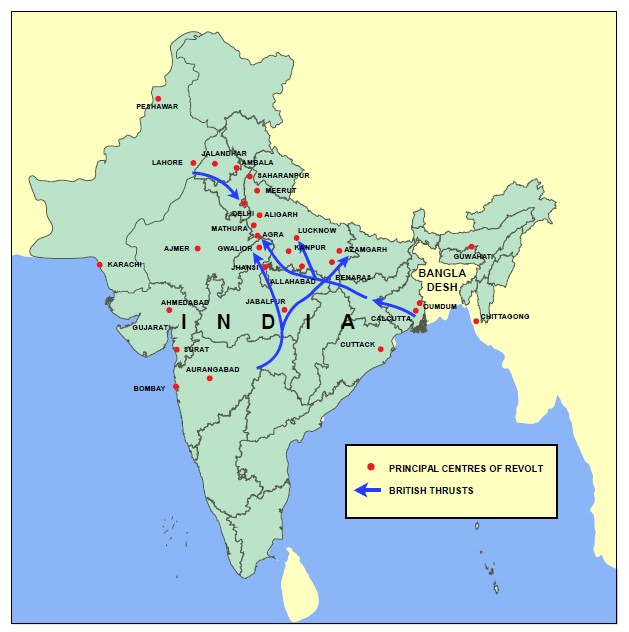Introduction
After the East India Company established British rule over the Indian territory, disappointment and anger started to thrive in the hearts and minds of the Indians. There were several reasons like the introduction of a permanent settlement system, widow remarriage act of 1856, subsidiary alliance and the doctrine of lapse, overseas wars in Burma, and more.
However, the main incident that caused the breakout of revolt of 1857 was the introduction of greased cartridges. It was made from the fats of pig and cow that violated Muslim and Hindu religion.
The sepoys refused to use those cartridges and it initiated the revolt.
The Course of the Great War of Independence
To understand the causes of the 1857 revolt, it is essential to understand the course of Mutiny that can be dated back to 1857, on 29th March. Mangal Panday rejected operating the cartridges and killed the deputy on this day. With him, 85 other enthusiasts at Meerut rejected the use of the same.
However, the significance of the revolt of 1857 provided a charge of imprisonment on the soldiers, which the other soldiers strongly opposed. In 1857, on 10th May, the soldiers killed the officers and headed towards Delhi. They requested the Mughal emperor Bahadur Shah II to take back the throne and help them fight against the British.
The revolt engulfed other cities like Lucknow, Delhi, Kanpur, Jagdishpur, Allahabad, Benares, Jhansi, and Kanpur. It further praised each cantonment of Bengal along with Bombay. Nevertheless, the Madras armies were devoted.
Reasons for the failure of the sepoy mutiny in 1857
- The revolt of 1857 was widespread indeed but it failed to bring together the entire country. Southern India never participated in the mutiny. In fact, many rulers who first contributed to the war backed out when they saw the defeat of the sepoys.
- The sepoy mutiny was more localized. Due to the lack of any central influence, it became easier for the British to suppress the revolts.
- No one was there to lead the sepoys and make them understand about the game plan. On the other hand, the British army was led by governors and expert military persons.
- One of the main reasons for the failure of the revolt of 1857 was the characters of the Bengal soldiers. They were hated everywhere and the uprisings were crushed down by the locals themselves.
- Even though they were a strong and united reason for the uprisings, the sepoys didn’t know whom to put in power if they were able to overthrow the British.
- The sepoys lacked unity and discipline unlike the British soldiers who were highly disciplined.
Impact of the revolt of 1857- The Great War of Independence
The impact of 1857 revolt are as follows:
End to the East India Company
One of the main impacts was the ending of the East India Company’s regime. The crown believed that to rule such a vast country with varied religions, a mere company won’t be enough. In fact, they feared that if the East India Company was there, then another uprising would happen sooner. So, the control was evoked and India was brought directly under the control of the British crown.
New intentions of the British
Even though the sepoys were defeated in the revolt of 1857, the Indians had hatred against the British government. That’s why the crown declared the government would not annex any more Indian states under the rule. In fact, new roles and titles were bestowed on the Indians like sanads, etc. They also declared that the main intention of the British government was to rule India with an eye for the good of the people.
Reorganization of the military
The military was completely reorganized. More Indians were included in the army and the ratio of British to Indians was increased. However, the new and advanced weapons were reserved only for the British troops. People with different religions were included in the same troops to pacify the idea of nationalism in the minds of people.
Queen Victoria’s proclamation post revolt of 1857
- No interference would be made with the religious aspects of the Indians
- All the Indians would receive equal opportunities as compared to the British subjects
- An official pardon was initiated to all Indians who didn’t murder British. However, those Indians who were directly responsible for the crimes were declared as guilty
- No distinction of creed, caste, and religion will be tolerated
- The reign of governors was put to an end and viceroys were appointed
Conclusion
The formation of the 1857 revolution presented horrifying historical evidence. The revolt of 1857 is also considered the intention of various classes to compete and create group rules. After this revolution, several problems started to grow with the British concept of divide and rule, which in the early stages were not present.

 Profile
Profile Settings
Settings Refer your friends
Refer your friends Sign out
Sign out













